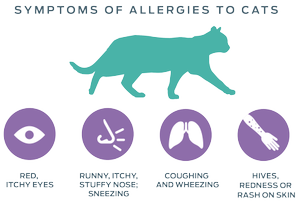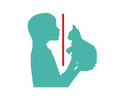
IGE BINDING FEL D1

Purina believes pets and people are better together. Unfortunately, cat-allergic owners may be forced to spend less time with their cat.

Allergies to cats: a common problem with consequences for both humans and cats.
Allergies can impair quality of life for allergy sufferers, leading to problems with social and daily activities as well as reduced productivity and concentration.1,2
Cat owners love their pets, and most consider them part of the family; for this reason, allergists’ guidelines-based recommendations to remove the cat from the home are often met with resistance.2-4 Allergies can impact the human-animal bond by limiting the quality of time with their cat.

FEL D 1
Watch the video and discover more about the major cat allergen
Long-standing allergy treatments have limitations

Allergies to cats are typically managed by
- Limiting or avoiding exposure to cats3
- Treating symptoms with medication9
- Desensitizing by receiving immunotherapy3,10
- Cleaning the environment2,3,11
Each of these approaches has limitations.
Reducing allergen load: A primary goal of allergy management
Allergic people are often sensitized to more than one allergen and each individual has an allergic threshold above which they will show allergic symptoms.12,13 Exposure to only one allergen may not be problematic, but exposure to several allergens simultaneously may lead to a cumulative effect (total allergen load) that exceeds that individual’s allergic threshold and triggers an allergic response.12 For example, someone with multiple pollen allergies may not develop symptoms when only one of those pollens is present, but they could develop symptoms in the spring when other pollen levels rise and raise the allergen load.
If the allergen load can be reduced by avoiding or reducing exposure to one or more of the contributing allergens, the cumulative level of allergen exposure may fall below an individual’s threshold and improve or prevent their allergic symptoms.12 Efforts to reduce allergen levels result in variable success for allergy sufferers, depending on whether or not the reduction in total allergen load falls below threshold and how long these levels remain below threshold.

Figure 1: Visual representation of the effects of cumulative allergen load on an individual's allergic threshold. In this case, the individual is exposed to multiple allergens in their home. Cumulatively, these exposures don't reach the individual's threshold and therefore, don't produce allergic symptoms. However, when certain seasonal pollens peak, the individual's allergic threshold can be exceeded and allergic symptoms occur.

Purina’s transformational approach to managing allergies to cats
A new approach for reducing Fel d 1 allergen load takes advantage of the antibody-allergen interaction to neutralize Fel d 1 after its production by the cat but before it spreads to the environment. A diet with an egg product ingredient containing anti-Fel d 1 IgY was fed to cats, resulting in significant decreases in active Fel d 1 (Fel d 1 that is capable of binding to IgE and triggering an allergic response in sensitized individuals) in the cats’ saliva. This will ultimately reduce active Fel d 1 levels in the environment, which will reduce symptoms in allergic people.14-16
Related Content
Find out more about this discovery, and what this could mean for the lives of cats and the people who care for them:
Find out more
1. Leynaert, B., Neukirch, C., Liard, R., Bousquet, J. & Neukirch, F. (2000). Quality of life in allergic rhinitis and asthma: A population-based study of young adults. American Journal of Respiratory and Critical Care Medicine, 162, 1391-1396.
2. Cosme-Blanco, W., Arce-Ayala, Y., Malinow, I. & Nazario, S. (2018). Primary and secondary environmental control measures for allergic diseases. In M. Mahmoudi (Ed.), Allergy and Asthma (pp. 1-36). Switzerland: Springer Nature. doi: 10.1007/978-3-319-58726-4_36-1
3. Dávila, I., Dominguez-Ortega, J., Navarro-Pulido, A., Alonso, A., Antolin-Amerigo, D., Gonzalez-Mancebo, E., Martin-Garcia, C., Nunez-Acevedo, B., Prior, N., …Torrecillas, M. (2018). Consensus document on dog and cat allergy. Allergy, 73(6), 1206-1222. doi: 10.1111/all.13391
4. Salo, P.M., Cohn, R.D., & Zeldin, D.C. (2018). Bedroom allergen exposure beyond house dust mites. Current Allergy and Asthma Reports, 18, 52. doi: 10.1007/s11882-018-0805-7
5. Bonnet, B., Messaoudi, K., Jacomet, F., Michaud, E. Fauquert, J.L., Caillaud, D., & Evrard, B. (2018). An update on molecular cat allergens: Fel d 1 and what else? Chapter 1: Fel d 1, the major cat allergen. Allergy, Asthma and Clinical Immunology, 14, 14. doi: 10.1186/s13223-018-0239-8
6. Butt, A., Rashid, D., & Lockey, R.F. (2012). Do hypoallergenic dogs and cats exist? Annals of Allergy, Asthma & Immunology, 108, 74-76. doi: 10.1016/j.anai.2011.12.005
7. Bastien, B., Gardner, C. & Satyaraj, E. Influence of time and phenotype on salivary Fel d 1 in domestic shorthair cats. In press, Journal of Feline Medicine and Surgery.
8. Kelly, S.M., Karsh, J., Marcelo, J., Boeckh, D., Stepner, N., Litt, D.,...Yang, W.H. (2018). Fel d 1 and Fel d4 levels in cat fur, saliva and urine. Journal of Allergy and Clinical Immunology, 142, 1990-1992.e3. doi: 10.1016/j.jaci.20107.033
9. Brown, L.C. & Slavin, R.G. (2005). Improving quality of life in patients with allergic rhinitis: The pharmacist’s role. Pharmacy Times. Retrieved from https://www.pharmacytimes.com/publications/issue/2005/2005-06/2005-06-9606 [accessed March 1, 2019] .
10. Mueller, R.S., Jensen-Jarolim, E., Roth-Walter, F., Marti, E., Janda, J., Seida, A.A. & DeBoer, D. (2018). Allergen immunotherapy in people, dogs, cats and horses – differences, similarities and research needs. Allergy, 73, 1989-1999. doi: 10.1111/all.13464
11. Björnsdottir, U.S., Jakobinudottir, S., Runarsdottir, V. & Juliusson S. (2003). The effect of reducing levels of cat allergen (Fel d 1) on clinical symptoms in patients with cat allergy. Annals of Allergy, Asthma and Immunology, 91, 189-194.
12. Wickman, M., Egmar, A.C., Emenius, G., Almqvist, C., Berglind, N., Larsson, P. & Van Hage-Hamsten, M. (1999). Fel d 1 and Can f1 in settled dust and airborne Fel d 1 in allergen avoidance day-care centres for atopic children in relation to number of pet-owners, ventilation and general cleaning. Clinical and Experimental Allergy, 29, 626-632.
13. Ciprandi, G., Alesina, R., Ariano, R., Aurnia, P., Borrelli, P., Cadario, G.,…Frati, F. (2008). Characteristics of patients with allergic polysensitization: the polismail study. European Annals of Allergy and Clinical Immunology, 40, 77-83.
14. Satyaraj, E., Li, Q., Sun, P. & Sherrill, S. Anti-Fel d 1 immunoglobulin Y antibody-containing egg ingredient lowers allergen levels in cat saliva. Submitted, Journal of Feline Medicine and Surgery.
15. Satyaraj, E., Gardner, C., Filipi, I., Cramer, K. & Sherrill, S. (2019). Reduction of active Fel d 1 from cats using an antiFel d 1 egg IgY antibody. Immunity, Inflammation & Disease. Advance online publication. doi: 10.1002/iid3.244
16. Wedner, H.J., Mantia, T., Satyaraj, E., Gardner, C., Al-Hammadi, N. & Sherrill, S. Feeding cats egg product with anti-Fel d 1 antibodies decreases environmental Fel d 1 and allergic response. Submitted, Journal of Allergy and Clinical Immunology.


